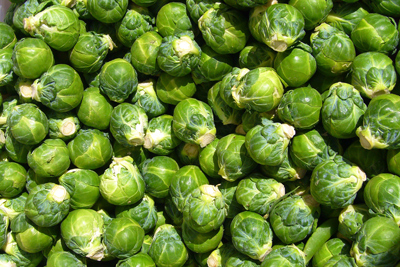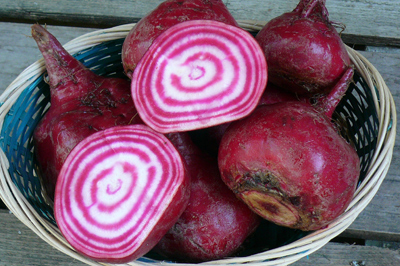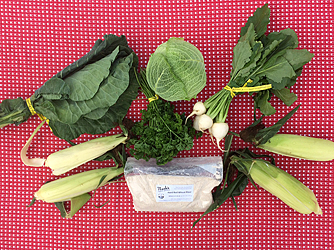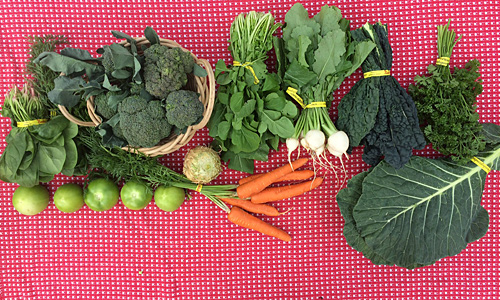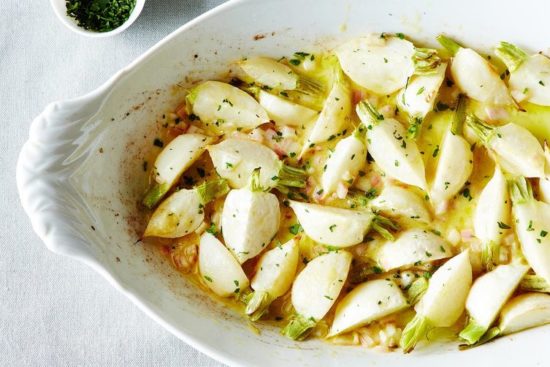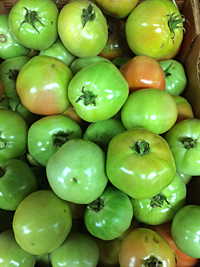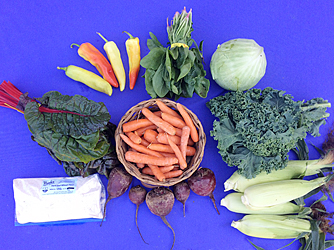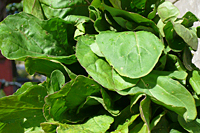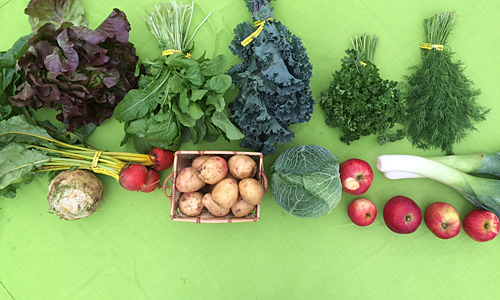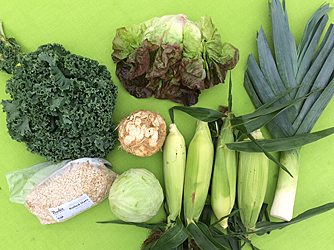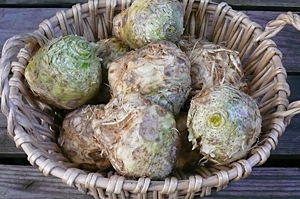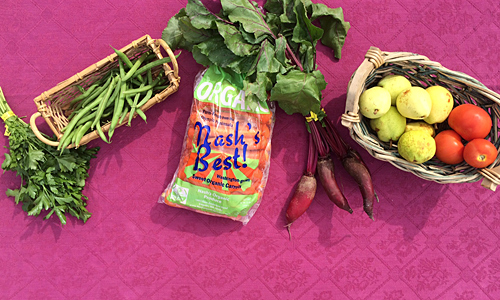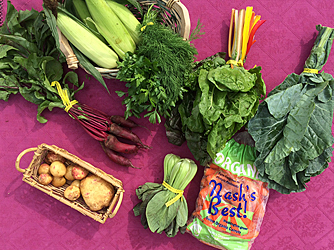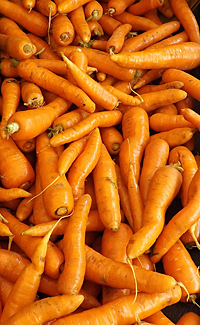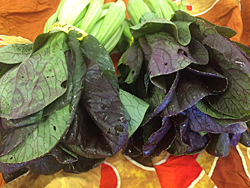In the Standard Box:
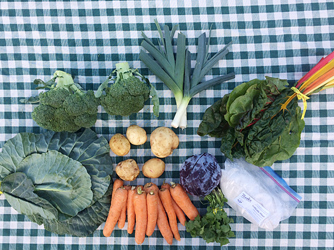
Collards 1 bu
Triticale Flour 2 lbs
Red Cabbage 1 hd
Cilantro 1 bu
Broccoli 3 lbs
Baby Leeks 2
Rainbow Chard 1 bu
Carrots 3 lb
Potatoes 2 lb
In the Small Box:
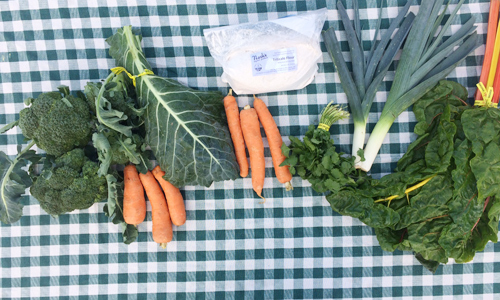
Collards 1 bu
Triticale Flour 2 lb
Cilantro 1 bu
Broccoli 3 lb
Baby Leeks 2
Rainbow Chard 1 bu
Carrots 2 lb
Rainbow Chard
Chard is closely related to beets. Like its cousin, it consists of two edible parts: its meaty dark-green leaves and its large, flat, celery-like stems or ribs, which can be cooked and served like asparagus. Young chard leaves are tender enough to eat raw, or they can be briefly steamed or blanched and used in most preparations that call for spinach. Rich, earthy, slightly salty, and yet bitter, chard makes a delicious, nutritious addition to soups, salads, quiches, and stir-fries.
Chard is one of nature’s nutritional powerhouses—it’s an outstanding source of vitamins A, C, and K, as well as magnesium, potassium, iron, copper, and dietary fiber, all for only 35 calories per cup. Research studies have found that its phytonutrients, particularly anthocyanins and carotenoids, may significantly reduce one’s risk of colon cancer.
Chard stems are delicious when braised in broth or other flavored cooking liquid for 20 to 25 minutes; the leaves can be added during the last 10 minutes.
Chard with Raisins and Almonds
¼ cup slivered almonds
2 pounds rainbow chard (or use red-stemmed chard)
½ cup water
½ cup apple juice
½ cup raisins
2 tablespoons butter
In a pan or using your oven broiler, toast the almonds. Wash the chard, but do not dry it. Cut the leaves away from the stems, stack several of them in a neat pile, and roll the leaves up like a cigar. Slice crosswise. Then cut the stems into ½-inch pieces.
In a large pan, cook the chard stems in the water for about 4 minutes; add the leaves and cook until they turn tender, 5 to 8 minutes. Stir in the apple juice and raisins, heating them thoroughly.
Top the chard with the butter and almonds, and toss lightly. Serve at once.
— Ruth Charles, Featherstone Farm CSA member, as appears in Bounty from the Box: The CSA Farm Cookbook, by Mi Ae Lipe
Got Carrots?
- Carrots can be roasted or even barbecued.
- Make a savory pudding using cooked carrots, chicken stock, butter, milk, nutmeg, black pepper, cayenne, and rice.
- Carrots, of course, are exceptional for juicing. They contain a lot of natural sugar, so be careful if pairing carrots with apple and beet juices to avoid overly sweet concoctions—and massive sugar highs.
- Like potatoes, carrots are the workhorses of the kitchen. Add them to soups, stews, casseroles, steaks, roasts, and a wide variety of other dishes for color, flavor, and nutrients.
- Raw carrots julienned in salads are a delight.
- Carrots are one of the traditional fillings for pasties, those little baked pastry shells filled with beef, potatoes, onions, turnips, or rutabagas.
- Carrot cake is a perennial favorite; use finely shredded carrots with cinnamon, mace, lemon peel, raisins, and chopped nuts.
- Pickled carrots can be quite an unexpected treat. Pickle with dill, mustard, and peppercorns.
- Along with celery and onion, carrots are one of the key ingredients in France’s mirepoix, a flavoring base for all respectable soups and many other dishes. Finely chop all three vegetables, and use twice as much onion as carrot and celery.
- Sometimes the simplest of vegetable dishes are the best. Braise whole baby vegetables like carrots, turnips, fennel, and pearl onions in butter, along with chicken stock, chervil, dill, and fresh shelled peas.
- Culinarily, carrots have a huge affinity for other members of their plant family. Cook them with dill, cumin, parsley, anise, cilantro, parsnips, and fennel.
Halloween Carrot Hands in Hummus
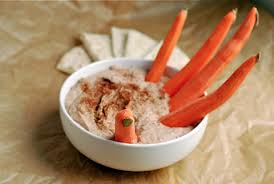
5 long carrots, or long carrot pieces
Pumpkins seeds or almond slices
1 recipe of your favorite hummus (check Nash’s Recipe Blog)
Chili powder or paprika for garnish
Set out your serving bowl, and estimate the length you’ll need the “fingers” to be. Select carrots that are most advantageously bent, and peel them. When peeling, add a flat part for the “nail.”
Fill your serving bowl with hummus and position the fingers. Use a bit of hummus to affix the pumpkin seeds or almond slices for nails. Garnish with chili powder or paprika for contrast, and serve with Triticale-Chia Crackers.
Triticale
Triticale is a whole-grain hybrid made by crossing wheat and rye, preserving the best of both plants and improving on both of its parents. This was first done in Sweden about 100 years ago.
Higher in protein and containing more minerals and fiber than either wheat or rye, triticale retains the earthy flavor of rye with the softer texture of wheat.
Triticale flour can be used to make yeast breads, but because it is lower in gluten than wheat, the loaf will not rise very high.
Triticale-Chia Crackers
2 cups triticale flour
1 tsp. sea salt
1 tsp. baking powder
1/3 cup chia seeds
1 tsp. ground black pepper
4 tsp. olive oil
¾ – 1 cup lukewarm water
Preheat oven to 350 degrees F. Stir the flour, salt, baking powder, chia seeds, and pepper together in a large bowl. Add the olive oil and ¾ cup water. Mix to incorporate all ingredients, adding more water if necessary for dough to hold together. Knead a few times until dough is smooth. Let sit for 10 minutes.
Grease two large cookie sheets or jelly-roll pans. Divide dough in half. Using a rolling pin, roll dough to cover each cookie sheet, rolling dough as thin as possible. Prick dough all over with a fork and cut into desired size with a pizza cutter. Bake for 20 minutes or until crackers are golden brown. Remove from oven, let cool. Break into individual crackers and store in a sealed container.

